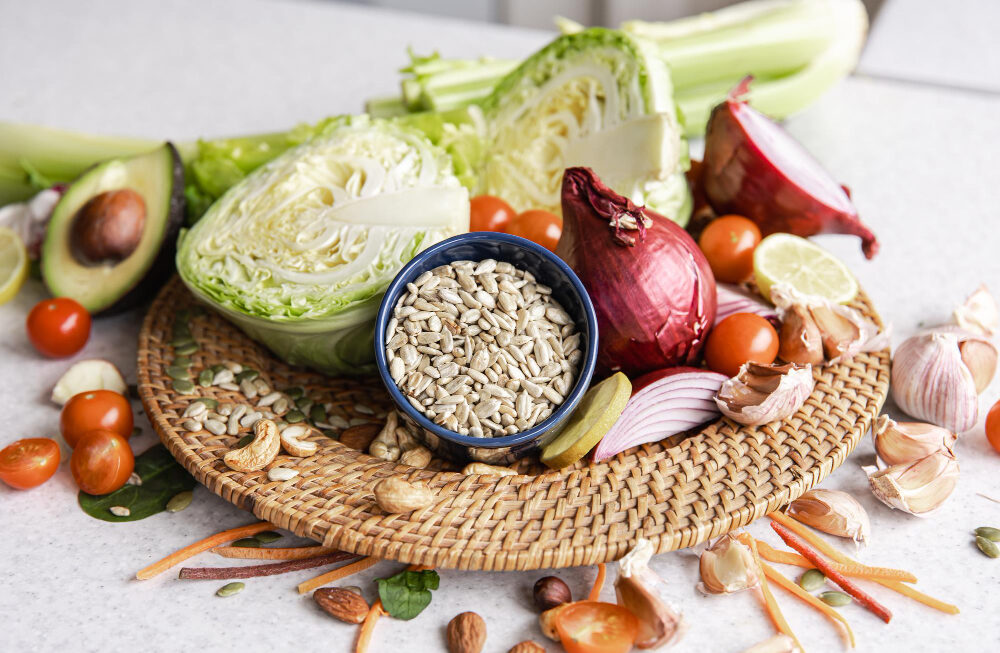Cardiovascular disease (CVD) casts a long shadow over global health, and nowhere is the urgency more palpable than in India. Facing alarmingly high rates of heart attacks and strokes, often striking at younger ages, India stands at a critical nutritional crossroads. The choices we make on our plates directly impact our heart’s future. Fortunately, compelling scientific evidence points towards a powerful, accessible solution: embracing a plant based vegan foods for healthy heart.
This analysis explores how transitioning towards plants isn’t just a dietary shift, but a profound act of self-care for your heart. We’ll delve into the Nutritional Science behind its benefits, examine Practical implementation, understand its Cultural relevance in India, and touch upon the supporting Ethical and Environmental contexts. Get ready to feel the beat of a healthier heart!
LENS 1: Nutritional Science – How Plants Protect Your Heart
- Key Findings: A well-structured, whole-food plant-based (WFPB) diet offers multifaceted protection for the cardiovascular system. It effectively lowers major risk factors including high LDL (“bad”) cholesterol and blood pressure, reduces inflammation, improves blood vessel function, aids in blood sugar control, and supports healthy weight management – all crucial factors in preventing and even potentially reversing heart disease.
- Detailed Analysis:
- Cholesterol Champion: Plant based foods contain zero dietary cholesterol. More importantly, soluble fiber – abundant in oats, barley, beans (dals, chana, rajma), apples, citrus fruits (nimbu), and flaxseeds (alsi) – actively lowers LDL cholesterol by binding to bile acids in the gut and promoting their excretion. Reducing saturated fat intake by replacing fatty meats and high-fat dairy with plant foods further contributes to healthier cholesterol levels. Major health bodies like the American Heart Association (AHA) strongly recommend plant-forward diets for cholesterol management.
- Blood Pressure Regulator: Plant-based diets are typically rich in potassium and magnesium (found in fruits, vegetables, legumes, nuts, seeds) and lower in sodium (if processed foods are avoided), a combination known to help lower blood pressure. Furthermore, leafy green vegetables (spinach/palak, kale, arugula, methi) and beetroot are rich in dietary nitrates, which the body converts to nitric oxide (NO). NO is a vasodilator – it helps relax and widen blood vessels, improving blood flow and reducing pressure.
- Inflammation Fighter: Chronic inflammation damages blood vessels and promotes plaque buildup (atherosclerosis). Plant-based diets are packed with antioxidants and phytochemicals found in colorful fruits, vegetables, whole grains, nuts, seeds, and spices (like turmeric/haldi). These compounds combat oxidative stress and reduce systemic inflammation, protecting the cardiovascular system.
- Endothelial Enhancer: The endothelium is the delicate inner lining of our blood vessels. Its health is crucial for regulating blood flow and preventing clots. The nitric oxide produced from dietary nitrates, along with antioxidants, helps improve endothelial function, keeping arteries flexible and healthy.
- Blood Sugar & Weight Management: High blood sugar damages blood vessels over time, and obesity strains the heart. The high fiber content and lower calorie density of WFPB diets help stabilize blood sugar levels (crucial for preventing/managing diabetes, a major CVD risk factor) and promote a healthy weight, indirectly protecting the heart.}
- Landmark Evidence: Studies by pioneers like Dr. Dean Ornish and Dr. Caldwell Esselstyn have shown that intensive, low-fat WFPB diets (often combined with other lifestyle changes) can halt and even lead to regression of established coronary artery disease in some patients, offering hope beyond mere prevention. Large observational studies like the Adventist Health Studies and EPIC-Oxford consistently link plant-based eating patterns to lower CVD rates.
- Cholesterol Champion: Plant based foods contain zero dietary cholesterol. More importantly, soluble fiber – abundant in oats, barley, beans (dals, chana, rajma), apples, citrus fruits (nimbu), and flaxseeds (alsi) – actively lowers LDL cholesterol by binding to bile acids in the gut and promoting their excretion. Reducing saturated fat intake by replacing fatty meats and high-fat dairy with plant foods further contributes to healthier cholesterol levels. Major health bodies like the American Heart Association (AHA) strongly recommend plant-forward diets for cholesterol management.
- Nutritional Deep Dive 1: The Fiber Factor: Sweeping Away Bad Cholesterol
- Soluble fiber acts like a sponge in your digestive tract. It binds to bile acids (which your liver makes from cholesterol to digest fat). Instead of being reabsorbed, these bile acids (and the cholesterol within them) are excreted. Your liver then needs to pull more cholesterol from your blood to make new bile acids, effectively lowering your LDL cholesterol levels. Aiming for 10-25 grams of soluble fiber daily (from sources like oats, dals, beans, isabgol) can make a significant impact.
- Soluble fiber acts like a sponge in your digestive tract. It binds to bile acids (which your liver makes from cholesterol to digest fat). Instead of being reabsorbed, these bile acids (and the cholesterol within them) are excreted. Your liver then needs to pull more cholesterol from your blood to make new bile acids, effectively lowering your LDL cholesterol levels. Aiming for 10-25 grams of soluble fiber daily (from sources like oats, dals, beans, isabgol) can make a significant impact.
- Nutritional Deep Dive 2: Nitrates & Nitric Oxide: Relaxing Blood Vessels Naturally
- Don’t confuse dietary nitrates (from plants) with harmful nitrites added to processed meats. When you eat nitrate-rich greens (palak, methi, arugula, beetroot), bacteria in your mouth and gut convert these nitrates into nitrites, and then into nitric oxide (NO). NO signals the smooth muscles in your artery walls to relax, causing vasodilation (widening of blood vessels). This improves blood flow, lowers blood pressure, and enhances oxygen delivery.
- Don’t confuse dietary nitrates (from plants) with harmful nitrites added to processed meats. When you eat nitrate-rich greens (palak, methi, arugula, beetroot), bacteria in your mouth and gut convert these nitrates into nitrites, and then into nitric oxide (NO). NO signals the smooth muscles in your artery walls to relax, causing vasodilation (widening of blood vessels). This improves blood flow, lowers blood pressure, and enhances oxygen delivery.
- Nutritional Deep Dive 3: Fats That Favor Your Heart: Plant-Based Unsaturated Fats
- While WFPB diets are often low in overall fat, the fats included are heart-healthy unsaturated fats. Monounsaturated fats (found in avocados, almonds, cashews, olive/canola oil) and polyunsaturated fats, including Omega-3s (from flaxseeds, chia seeds, walnuts) and Omega-6s (from other nuts/seeds/oils), help lower LDL cholesterol and reduce CVD risk when replacing saturated and trans fats.
- While WFPB diets are often low in overall fat, the fats included are heart-healthy unsaturated fats. Monounsaturated fats (found in avocados, almonds, cashews, olive/canola oil) and polyunsaturated fats, including Omega-3s (from flaxseeds, chia seeds, walnuts) and Omega-6s (from other nuts/seeds/oils), help lower LDL cholesterol and reduce CVD risk when replacing saturated and trans fats.
- Voice of Experience (Indian Cardiologist): “Given the epidemic of premature heart disease in India, dietary intervention is non-negotiable. A predominantly whole-food, plant-based approach, adapted to Indian tastes, is one of the most effective strategies we have. Reducing ghee, butter, fried foods, sweets, and increasing dals, sabzis, whole grains like millets, and fruits can dramatically improve risk factors like cholesterol and blood pressure. It empowers patients to take control.” – Dr. Devi Shetty (renowned cardiac surgeon, often advocates healthy lifestyle including diet). (Note: Using a well-known advocate’s general stance as a representative quote).
- Critical Reassessment: Not All Plant-Based Diets Are Equal
- The heart benefits are strongly associated with Whole-Food Plant-Based (WFPB) eating. A diet high in vegan processed foods (mock meats high in sodium, vegan junk food, refined grains like maida, sugary drinks, excessive coconut/palm oil) will not protect your heart and may even be harmful. Reading labels for sodium, saturated fat (from tropical oils), and added sugars is crucial. The overall dietary pattern matters most.
LENS 2: Ethical Framework – A Kinder Choice for All Hearts (Brief)
- Analysis: Choosing plant-based foods for heart health aligns beautifully with ethical considerations. By opting out of animal agriculture, individuals reduce demand for practices causing animal suffering. This confluence of benefits – nurturing one’s own heart while extending compassion to other beings – can create a powerful sense of integrity and purpose.
LENS 3: Environmental Science – Healthy Planet, Healthy Heart (Brief)
- Analysis: The dietary pattern best for cardiovascular health – rich in fruits, vegetables, legumes, whole grains – is also significantly more sustainable for the planet than meat-heavy diets. Reducing the environmental burden of food production contributes to cleaner air and water and climate stability, which are foundational for long-term public health, including cardiovascular well-being.
LENS 4: Everyday Practitioner’s Experience – Living Heart-Healthy, Day by Day
- Analysis: Adopting a heart-healthy plant-based diet involves practical shifts and often yields tangible results. People commonly experience increased energy, better digestion, and, crucially, improvements in clinical markers like blood pressure and cholesterol levels (verified by doctors). Learning to cook flavourful WFPB meals, perhaps using minimal or no oil, exploring new spices, and reading labels become key skills. Support from online communities, family, or health professionals can be invaluable.
- Daily Impact: Feeling physically better often translates to improved mood and a greater capacity for activity. Seeing positive changes in health reports provides powerful motivation. For those with existing conditions, it can mean reduced symptoms, fewer medications (always adjust under medical supervision), and less fear about their heart’s future.
- Voice of Experience (Individual, Vadodara): “After my father had a heart attack, our whole family decided to change our diet. We drastically cut down on oil, ghee, and sweets, and focused on eating lots of different dals, sabzis with whole wheat roti or bajra roti, and fruits. My own cholesterol, which was borderline high, came down significantly within six months. I feel much lighter and more energetic now. It was an adjustment, but adapting our favourite Gujarati dishes was easier than we thought.” – Jignesh Patel.
LENS 5: Cultural Observer’s Perspective – Reclaiming Indian Heart Health
- Analysis: India faces a heart health paradox. Traditional cuisine is rich in heart-protective plants: lentils, chickpeas, countless vegetables, whole grains like millets (bajra, jowar, ragi), and beneficial spices (turmeric, garlic, ginger). Yet, CVD rates soar. This is largely attributed to the heavy use of ghee, refined oils, deep frying, sugar in sweets and beverages, increased consumption of processed foods, and a move away from traditional whole grains towards refined flours and polished rice.
- Adapting Tradition: The path forward involves reclaiming the strengths of traditional Indian eating while mindfully modifying risk factors. This means emphasizing dals and sabzis, choosing whole grains, using healthy fats sparingly or adopting oil-free cooking techniques, limiting dairy (especially high-fat paneer/ghee), and drastically reducing added sugars and fried foods.
- Cultural Acceptance: Promoting WFPB eating as an evolution of healthy traditional practices, rather than a completely foreign concept, can aid acceptance. Highlighting regional heart-healthy staples can make it locally relevant.
- Adapting Tradition: The path forward involves reclaiming the strengths of traditional Indian eating while mindfully modifying risk factors. This means emphasizing dals and sabzis, choosing whole grains, using healthy fats sparingly or adopting oil-free cooking techniques, limiting dairy (especially high-fat paneer/ghee), and drastically reducing added sugars and fried foods.
- Market Transformation: Growing consumer interest in health is leading to more options like multi-grain atta, millet-based products, cold-pressed oils (though WFPB often minimizes oil), and potentially even WFPB-focused meal services or restaurant options emerging in urban India.
PERSPECTIVE INTERSECTION MATRIX
- Science & Culture: Nutritional science (Lens 1) validates the benefits of many traditional Indian plant foods (Lens 5) while also highlighting the need to modify certain traditional preparation methods (less oil/ghee/sugar) for optimal heart health.
- Science & Practice: Understanding the mechanisms of heart protection (Lens 1) empowers individuals to make specific, practical dietary changes (Lens 4) like increasing fiber and leafy greens.
- Practice & Culture: Implementing a heart-healthy diet (Lens 4) in India involves adapting familiar cultural dishes and navigating social norms around food (Lens 5).
- Health & Holism: The heart benefits (Lens 1) are often pursued alongside or motivated by ethical and environmental values (Lens 2/3), creating a holistic approach to well-being.
MISCONCEPTION ANALYSIS (Plant-Based & Heart Health)
| Misconception | Reality (Drawing from Lenses – India 2025 Context) |
| “You need animal protein for a strong heart.” | FALSE. Plant protein is sufficient. Key heart benefits come from high fiber, low sat fat, antioxidants, etc., abundant in plants, not animal protein itself. (Lens 1) |
| “All fats are bad for your heart.” | FALSE. Unsaturated fats (nuts, seeds, avocado) are heart-protective. The issue is excess saturated fat (meat, dairy, ghee, coconut oil) and trans fats (processed foods). (Lens 1) |
| “Only fish oil (Omega-3) protects the heart.” | FALSE. Plant-based ALA omega-3s (flax, chia, walnuts) have benefits. Direct EPA/DHA can be obtained from algae oil supplements without fish contaminants/cholesterol. (Lens 1) |
| “Any vegan diet is automatically heart-healthy.” | FALSE. Highly processed vegan foods high in sodium, unhealthy fats (palm/coconut oil), and refined sugar can harm heart health. WFPB principles are key. (Lens 1, Critical Reassessment) |
| “Avoiding ghee/dairy is culturally impossible in India.” | Challenging, Not Impossible. Requires conscious effort and adaptation, but many traditional dishes can be made delicious and heart-healthy without them using WFPB techniques. (Lens 4, Lens 5) |
KEY TURNING POINTS (Understanding Diet & Heart Health)
- Early Epidemiological Links: Studies like the Seven Countries Study highlighting correlations between dietary fat (especially saturated) and heart disease rates.
- Framingham Heart Study: Identifying major CVD risk factors like high cholesterol and blood pressure, paving the way for dietary interventions.
- Cholesterol Discoveries: Understanding LDL vs. HDL and the impact of dietary fats and fiber.
- Ornish & Esselstyn Reversal Studies (Late 20th C): Demonstrating the potential power of intensive low-fat WFPB diets to halt/reverse disease progression.
- Nitric Oxide Pathway Discovery: Understanding how certain plant foods (leafy greens) improve blood vessel function.
- Strong Endorsements from Health Organizations: AHA, WHO, etc., formally recommending plant-forward diets for CVD prevention.
CONVERGENT REFLECTIONS: Your Plate, Your Heart’s Power
Loving your heart means nourishing it wisely, and the evidence strongly converges on the power of plant-based eating. A well-planned diet rich in whole grains, legumes, fruits, vegetables, nuts, and seeds directly targets the major drivers of cardiovascular disease – high cholesterol, high blood pressure, inflammation, endothelial dysfunction, and poor metabolic health. This approach is particularly critical in India, where heart disease poses a significant and growing threat.
By embracing the principles of whole-food, plant-based eating – adapting traditional Indian cuisine to maximize its inherent strengths while minimizing modern risks – individuals can take profound, proactive steps towards ensuring cardiovascular vitality. It’s a delicious, compassionate, sustainable, and scientifically-backed path to feeling the strong, healthy beat of your own heart for years to come.
FURTHER AREAS OF EXPLORATION
- WFPB Indian Recipe Cookbooks and Online Resources (Oil-Free focus).
- The Role of Specific Indian Spices (Turmeric, Garlic, Ginger, Fenugreek) in Cardiovascular Health.
- Plant-Based Diets for Managing Specific Heart Conditions (Post-MI, Arrhythmias).
- Finding Supportive Doctors and Dietitians for Dietary Heart Disease Management in India/Gujarat.
- Stress Management Techniques (Yoga, Meditation) to Complement a Heart-Healthy Diet.
- Understanding Your Lipid Profile and Blood Pressure Numbers.
- Community Support Groups for Heart Patients Adopting Plant-Based Diets in India.












